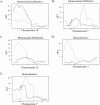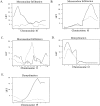Identification of genetic loci controlling the characteristics and severity of brain and spinal cord lesions in experimental allergic encephalomyelitis
- PMID: 10934166
- PMCID: PMC1850129
- DOI: 10.1016/S0002-9440(10)64574-9
Identification of genetic loci controlling the characteristics and severity of brain and spinal cord lesions in experimental allergic encephalomyelitis
Abstract
Experimental allergic encephalomyelitis (EAE) is the principal genetically determined animal model for multiple sclerosis (MS), the major inflammatory disease of the central nervous system (CNS). Although genetics clearly play a role in susceptibility to MS, attempts to identify the underlying genes have been disappointing. Considerable variation exists between MS patients with regard to the severity of clinical signs, mechanism of demyelination, and location of CNS lesions, confounding the interpretation of genetic data. A mouse-human synteny mapping approach may allow the identification of candidate susceptibility loci for MS based on the location of EAE susceptibility loci. To date, 16 regions of the mouse genome have been identified that control susceptibility or clinical signs of EAE. In this work, we examined the genetic control of histopathological lesions of EAE in an F2 intercross population generated from the EAE susceptible SJL/J and EAE resistant B10.S/DvTe mouse strains. Composite interval mapping was used to identify 10 quantitative trait loci (QTL), including seven newly identified loci controlling the distribution and severity of CNS lesions associated with murine EAE. QTL on chromosome 10 control lesions in the brain, whereas QTL on chromosomes 3, 7, and 12 control lesions in the spinal cord. Furthermore, sexually dimorphic QTL on chromosomes 2, 9, and 11 control CNS lesions in females, whereas QTL on chromosomes 10, 11, 12, 16, and 19 control lesions in males. Our results suggest that the severity and location of CNS lesions in EAE are genetically controlled, and that the genetic component controlling the character and severity of the lesions can be influenced by sex.
Figures



Similar articles
-
Sequence polymorphisms in the chemokines Scya1 (TCA-3), Scya2 (monocyte chemoattractant protein (MCP)-1), and Scya12 (MCP-5) are candidates for eae7, a locus controlling susceptibility to monophasic remitting/nonrelapsing experimental allergic encephalomyelitis.J Immunol. 1999 Aug 15;163(4):2262-6. J Immunol. 1999. PMID: 10438970
-
Identification of quantitative trait loci controlling cortical motor evoked potentials in experimental autoimmune encephalomyelitis: correlation with incidence, onset and severity of disease.Hum Mol Genet. 2005 Jul 15;14(14):1977-89. doi: 10.1093/hmg/ddi203. Epub 2005 May 25. Hum Mol Genet. 2005. PMID: 15917267
-
New genetic loci that control susceptibility and symptoms of experimental allergic encephalomyelitis in inbred mice.J Immunol. 1998 Aug 15;161(4):1860-7. J Immunol. 1998. PMID: 9712054
-
Genetics of experimental autoimmune encephalomyelitis in the mouse.Arch Immunol Ther Exp (Warsz). 2004 Sep-Oct;52(5):316-25. Arch Immunol Ther Exp (Warsz). 2004. PMID: 15507872 Review.
-
The gelatinases, MMP-2 and MMP-9, as fine tuners of neuroinflammatory processes.Matrix Biol. 2019 Jan;75-76:102-113. doi: 10.1016/j.matbio.2017.11.007. Epub 2017 Nov 21. Matrix Biol. 2019. PMID: 29158162 Review.
Cited by
-
Genetic determinants of risk and progression in multiple sclerosis.Clin Chim Acta. 2015 Sep 20;449:16-22. doi: 10.1016/j.cca.2015.01.034. Epub 2015 Feb 4. Clin Chim Acta. 2015. PMID: 25661088 Free PMC article. Review.
-
Gender, age, and season at immunization uniquely influence the genetic control of susceptibility to histopathological lesions and clinical signs of experimental allergic encephalomyelitis: implications for the genetics of multiple sclerosis.Am J Pathol. 2004 Nov;165(5):1593-602. doi: 10.1016/S0002-9440(10)63416-5. Am J Pathol. 2004. PMID: 15509529 Free PMC article.
-
Biological Sex As a Critical Variable in CD4+ Effector T Cell Function in Preclinical Models of Multiple Sclerosis.Antioxid Redox Signal. 2022 Jul;37(1-3):135-149. doi: 10.1089/ars.2021.0202. Epub 2022 Jan 4. Antioxid Redox Signal. 2022. PMID: 34538129 Free PMC article. Review.
-
Association of a common polymorphism in the promoter of UCP2 with susceptibility to multiple sclerosis.J Mol Med (Berl). 2005 Oct;83(10):806-11. doi: 10.1007/s00109-005-0661-5. Epub 2005 Jul 15. J Mol Med (Berl). 2005. PMID: 16021520
-
Definition of a 1.06-Mb region linked to neuroinflammation in humans, rats and mice.Genetics. 2006 Jul;173(3):1539-45. doi: 10.1534/genetics.106.057406. Epub 2006 Apr 19. Genetics. 2006. PMID: 16624898 Free PMC article.
References
-
- Ebers GC, Sadovnick AD, Risch NJ: A genetic basis for familial aggregation in multiple sclerosis. Canadian Collaborative Study Group [see comments]. Nature 1995, 377:150-151 - PubMed
-
- Ewing C, Bernard CC: Insights into the etiology and pathogenesis of multiple sclerosis. Immunol Cell Biol 1998, 76:47-54 - PubMed
-
- Sawcer S, Jones HB, Feakes R, Gray J, Smaldon N, Chataway J, Robertson N, Clayton D, Goodfellow PN, Compston A: A genome screen in multiple sclerosis reveals susceptibility loci on chromosome 6p21 and 17q22 [see comments]. Nat Genet 1996, 13:464-468 - PubMed
-
- Haines JL, Ter Minassian M, Bazyk A, Gusella JF, Kim DJ, Terwedow H, Pericak-Vance MA, Rimmler JB, Haynes CS, Roses AD, Lee A, Shaner B, Menold M, Seboun E, Fitoussi RP, Gartioux C, Reyes C, Ribierre F, Gyapay G, Weissenbach J, Hauser SL, Goodkin DE, Lincoln R, Usuku K, Oksenberg JR: A complete genomic screen for multiple sclerosis underscores a role for the major histocompatability complex. The Multiple Sclerosis Genetics Group. Nat Genet 1996, 13:469–471 - PubMed
-
- Ebers GC, Kukay K, Bulman DE, Sadovnick AD, Rice G, Anderson C, Armstrong H, Cousin K, Bell RB, Hader W, Paty DW, Hashimoto S, Oger J, Duquette P, Warren S, Gray T, O’Connor P, Nath A, Auty A, Metz L, Francis G, Paulseth JE, Murray TJ, Pryse-Phillips W, Risch N: A full genome search in multiple sclerosis [see comments]. Nat Genet 1996, 13:472-476 - PubMed
Publication types
MeSH terms
Grants and funding
LinkOut - more resources
Full Text Sources
Other Literature Sources
Molecular Biology Databases
Miscellaneous

